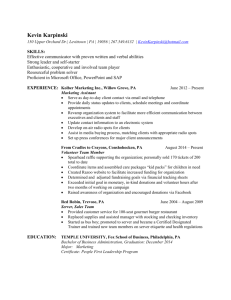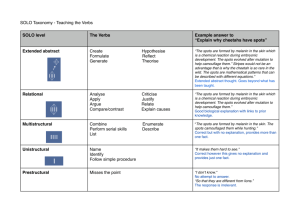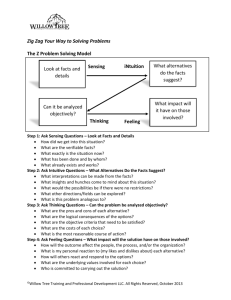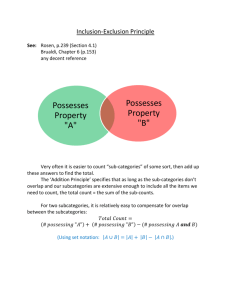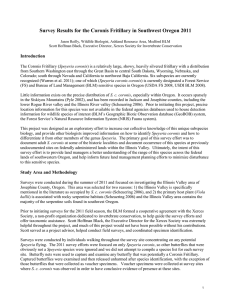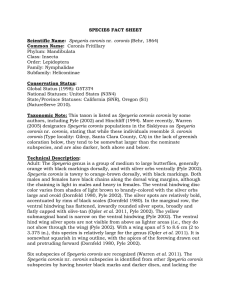Coronis Fritillary Field Identification: Reference Guide
advertisement
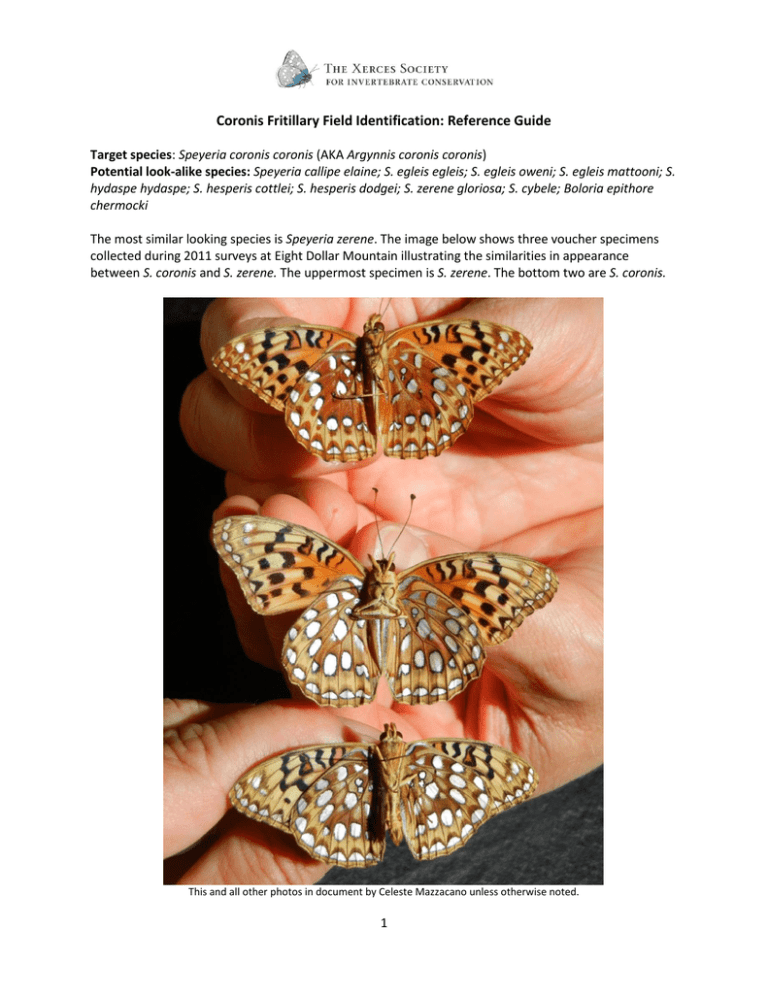
Coronis Fritillary Field Identification: Reference Guide Target species: Speyeria coronis coronis (AKA Argynnis coronis coronis) Potential look-alike species: Speyeria callipe elaine; S. egleis egleis; S. egleis oweni; S. egleis mattooni; S. hydaspe hydaspe; S. hesperis cottlei; S. hesperis dodgei; S. zerene gloriosa; S. cybele; Boloria epithore chermocki The most similar looking species is Speyeria zerene. The image below shows three voucher specimens collected during 2011 surveys at Eight Dollar Mountain illustrating the similarities in appearance between S. coronis and S. zerene. The uppermost specimen is S. zerene. The bottom two are S. coronis. This and all other photos in document by Celeste Mazzacano unless otherwise noted. 1 Coronis Fritillary Field Identification: Quick Reference Guide Target species: S. coronis coronis Specimens in box above photographed and compiled by Caitlin LaBar. Specimens from Jackson, Lake and Klamath Counties, Oregon. 2 SPECIES DESCRIPTIONS: Fritillaries in Jackson & Josephine Counties Descriptions derived from The Butterflies of Cascadia by Robert Michael Pyle (2002) Speyeria coronis nominate: large (<3”); tawny orange ground color; males w/black chains along margins. FW tip drawn out. VHW discs tan to brandy with silver orbs large and ovoid. Marginal silver spots flattened, broadly and flatly capped with olive tan. VHW silver spots not visible from above as lighter areas. Wings longer than S. callipe. May-Sept., peak June, Aug. S. c. coronis: found sparsely in Siskiyous; heavier black marks and darker discs; somewhat larger and darker above and below than nominate. Lack greenish tinge to ventral ground color seen in fresh specimens of other subspp. Speyeria callipe nominate: medium-large (<2.5”); wings relatively short and triangular. Pattern of silver spots beneath conspicuously indicated by lighter spots above. Black border chains prominent, esp. in females. VFW pink at base. VHW reddish brown to olive to green. Big oval silver spots; those in submarginal row triangular, capped w/smaller green or brown triangles. May-Sept., peak in June-July. S. c. elaine: more orange above; thick black veins; brown-disked and often unsilvered below (level of silvering varies). Strongly attracted to mint flowers in gulleys and canyons around Siskiyou pass, dogbane at roadside ditches. 3 Speyeria egleis nominate: smaller (<2.25”) and shorter-winged than other spp. Bright– to brown-orange above, heavy dark scaling on veins and basally with pallor between dark spots. Silver spots beneath smallish and rounded, set in variable disc often muddy brown shot with olive or straw. June-Sept., peak in July. S. e. egleis: dull orange above, tan below, with or without silvering. Southern Jackson and Josephine Co. S. e. oweni: darker above & below, disk dull reddish or purplish, band tan, spots silvered. E. Jackson Co. S. e. mattooni: slightly darker than S. e. oweni, mostly unsilvered. Southern Jackson & Josephine Co. Left = male, right = female. S. e. mattooni photos by Kim Davis and Mike Stangeland 4 Speyeria hesperis nominate: medium-large (>2.5”). Bright tawny or citrus orange above with strong black spots and border chains (heavier on females), black scaling on veins and base of wings. VHW disc dark – or milk-chocolate brown, spots silvered or VHW disc reddish-brown, spots often unsilvered. Submarginal band narrow to medium, buffy yellow crossed by dark veins. June-Sept., peak in July. (Note: considered conspecific w/ S. atlantis by Pyle.) S. h. dodgei: larger; heavy black markings; ventral spots cream; VHW disc brick-red shot with tan, pinkish submarginal band with dark borders above. In southern Josephine Co., southern & northeastern Jackson Co. S. h. cottlei: larger and darker both dorsally and ventrally than S. h. dodgei; left = male, right = female S. h. cottlei photos by Kim Davis and Mike Stangeland. 5 Speyeria hydaspe nominate: medium (>2.25”). Wings rather short, rounded. Heavy dorsal wing pattern on dark orange-brown disc; VHW rusty to maroon w/purple overtones; VHW marginal and discal spots yellow to cream, rarely silvered. Much variation between individuals and geographically. In forested habitats. June-Sept., peak in July. S. h. hydaspe: widespread, common; purple cast of ventral disc and submarginal band varies, more pronounced in southern populations. Much variability in SW Oregon. Some individuals, esp. females, may have trace of silvering on marginal row of spots. S. cybele: large (>3”), distinctive. Male fiery orange w/light black spotting, esp. on border; broad pale yellow postmarginal band below, cinnamon disk, few and small silver spots. Female yellowish above w/heavy black spots, suffused basally w/dark scales; like male below but much paler ground color, dark mahogany disc. June—Sept., peak in July. Photos this page by Caitlin LaBar. 6 Speyeria zerene nominate: medium-large (>2.5”); usually darker than S. coronis. FW rounded, HW angular. Reddish-orange above, darker overall at higher elevations. VHW disc usually reddish-brown or vinous, often with pale highlights. Prominent, medium-sized silver spots often shaded by dark scales. VHW marginal spots and brown caps usually triangular. June-Sept., peak in July. S. z. gloriosa: larger; males with VHW disc reddish brown and ochre band; females with deep chocolate disc with broad buff band overlaid with violet cast. Seen co-occurring with S. coronis coronis at Eight Dollar Mtn. Rd. (4, 6 July), Illinois River Rd. (July 9-10) and a site 1 mile W of O'Brian (10 July). At the latter, it was noted that S. z. gloriosa "can run amazingly close" to S. c. coronis. Boloria epithore nominate: much smaller than Speyeria (>1.75”); bright citrus orange, sharply inkspotted above with much open orange and no black border. FW with long rounded tips. VHW mottled lavender and russet with postbasal band of dirty orange-yellow spots ending in anvil-shaped pale mark on costa; broken rows of rusty brown or violet postmedian dots cross purplish disc. No silver spots on VHW. Submarginal brown triangles on DHW point outward. March-Sept., peak in June-Aug. B. e. chermocki: heavily marked with median row of black spots on DHW fused. Scattered through Josephine and Jackson Co. 7
